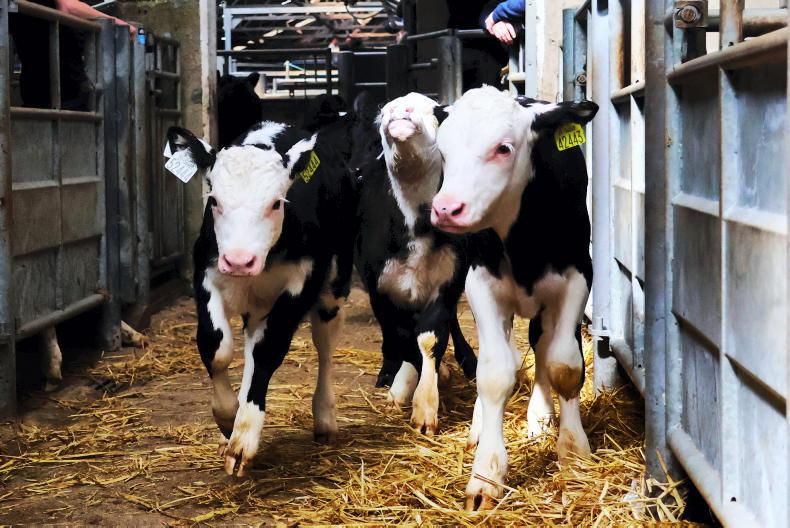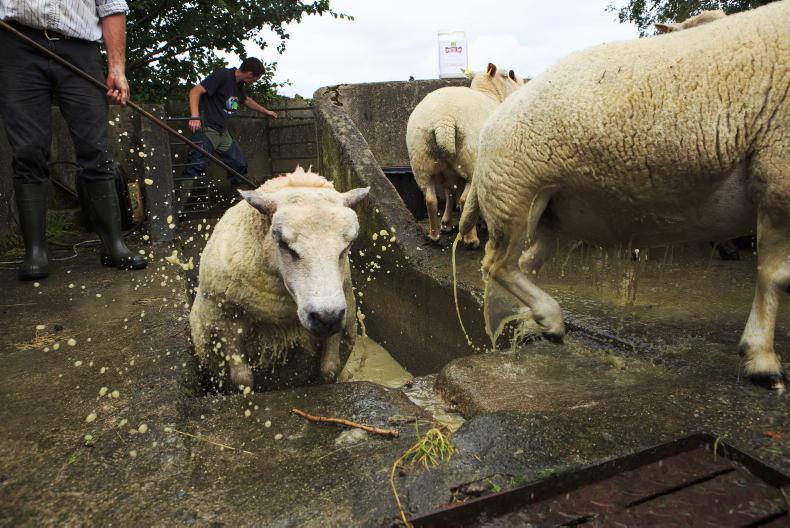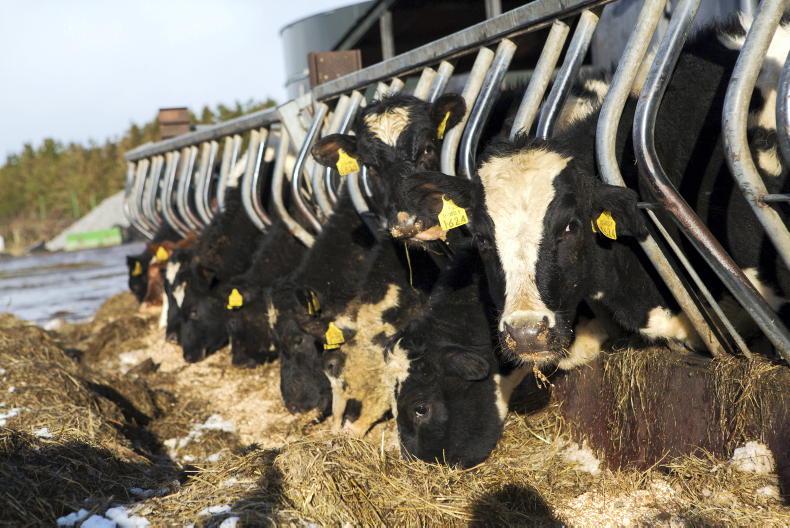Ten years ago, bloat in young calves was rarely if ever discussed on Irish farms.
However, it now appears to be a much more common issue, causing many costly and stressful problems on farms that are hit with it.
The exact causes of bloat are still not fully understood but, as discussed at the recent Teagasc/AHI Calf Care webinar, there are multiple factors which can cause bloat.
While it’s probably fair to say that the majority of bloat occurs when calves are fed milk replacer, it can happen when calves are fed whole milk also.
Much like with the case in older animals, bloat in young calves is caused by a buildup of gases in the stomach which can’t be released.
These gases put pressure on other organs and result in the calf being in severe distress. Case fatality rate is shockingly high, with 75% to 100% of calves dying, usually within six hours to two days.
In older calves, bloat can be either in the abomasum or rumen, while it’s always in the rumen in older cattle
An important distinction between bloat in calves and bloat in older stock is where the gas is built up. In calves less than three weeks of age, almost all of the absorption of feed takes place in the abomasum, so bloat occurs in the abomasum.
In older calves, bloat can be either in the abomasum or rumen, while it’s always in the rumen in older cattle.
There appear to be three factors involved in bloat cases in calves. These are:
1. The presence of gas-producing bacteria in the abomasum.2. Excess carbohydrates (milk) in the abomasum.3. Anything that slows down the digestion of milk in the abomasum. According to AHI, the primary cause of bloat is the excess fermentation of milk and milk replacer in the abomasum which creates an abundance of gas-producing bacteria which causes the abomasum to swell up and which in turn slows down the passage of milk through the abomasum.
On the one hand, you have the presence of these gas-producing bacteria such as Clostridium perfringens type A. These are naturally occurring and form part of the normal gut flora.
On the other hand, when there is too much readily digestible carbohydrate in the abomasum for them to feed on, such as too much milk or milk replacer, there is a spike in fermentation and gas production.
Perhaps more to the point, when the rate at which the abomasum empties out reduces (in other words, it remains fuller for longer), then there is a real risk of bloat because you have all this milk being fermented and all this gas being produced by the bacteria.
This points to a much higher risk of bloat where calves are fed high rates of milk.
In my view, the likelihood of this is much greater when using milk replacer either through manual feeding or through computerised calf feeders.
I say this because it is easier to accidentally over-feed calves when using milk replacer compared to whole milk. Plus, there is some evidence to say that the proteins in milk replacers can often be slower to digest than when feeding whole milk and thus the abomasal emptying rate is often slower than when whole milk is fed irrespective of the risk of bloat.
That’s not to say that feeding high rates of milk replacer are the only risks.
Feeding all milk with high osmality (highly concentrated), high fat and protein concentrations and inconsistent feeding times can affect abomasum emptying rates. Indeed, these factors can also lead to increased scour in calves.
Symptoms
The classic symptom of bloat is a dead calf with a ballooned stomach. Early identification of abomasal bloat, unlike rumen bloat, is less effective in terms of arriving at a cure because, unlike with rumen bloat, you are unable to pierce the abomasum to release the gas and you cannot pass a tube to release the gas. Affected calves will often look like they have a colic and kick their legs at their stomach, grind their teeth or salivate.
Prevention
Like with nearly everything to do with calf health, the first port of call is to ensure good colostrum management. Insufficient colostrum can reduce lactase activity which is needed to break down lactose and could affect the abomasal emptying rate.
It’s also important to make sure if using a stomach tube to feed colostrum that it is soft and free of abrasions or sharp points which can damage the vagal nerve which is responsible for movement of the abomasum and could again affect emptying rate.

The following is useful advice when feeding milk replacer:
Use the correct procedure every time milk replacer is being prepared. It’s important to check that the amount of solids in the milk replacer is correct and this can be done by testing a sample with the brix refractomer, like when testing colostrum quality. Typically, milk replacer is fed at a 12.5% solids rate but can be fed at rates of up to 15%. However, the higher the feeding rate, the higher the osmality, which affects emptying rate of the abomasum. If using computerised calf feeders, make sure that the feeder is correctly calibrated so that the right amount of milk replacer is being fed. Don’t presume it’s working. Cross-check with the amount of powder being used and the amount of calves being fed to assess feeding rates.Different milk replacers will have different bulk densities and there could even be differences in bulk density between different batches of the same product. It’s probably a good idea to use powder from the same batch for the duration of the rearing period. Definitely avoid chopping and changing between different brands. According to the AHI/Teagasc guidance, some milk replacers need to be mixed in water at 55°C in order to ensure some of the palm oil or coconut oil ingredients are fully dissolved. The maximum amount of milk that should be fed in one feed is 3l. Feeding larger volumes means it will take longer for the milk to leave the abomasum. This is particularly relevant for those on once-a-day feeding.Replace any worn or cracked teats on feeders that could increase drinking speed or harbour pathogens. Ensure there is sufficient fresh, clean water present in the pen. This is essential as it reduces the concentration of liquid in the abomasum. Calves should also be eating calf starter ration from three days of age. This should be fed fresh daily with stale meal removed. Keep feeding equipment clean as poor hygiene can result in excess bacterial growth. Teats on computerised feeders should be changed every two days and washed and left to soak in peracetic acid before being reused. Use chlorine-based liquid detergents for washing computerised feeders. Most milking equipment detergents are chlorine free and are less effective than chlorine-based products.
Ten years ago, bloat in young calves was rarely if ever discussed on Irish farms.
However, it now appears to be a much more common issue, causing many costly and stressful problems on farms that are hit with it.
The exact causes of bloat are still not fully understood but, as discussed at the recent Teagasc/AHI Calf Care webinar, there are multiple factors which can cause bloat.
While it’s probably fair to say that the majority of bloat occurs when calves are fed milk replacer, it can happen when calves are fed whole milk also.
Much like with the case in older animals, bloat in young calves is caused by a buildup of gases in the stomach which can’t be released.
These gases put pressure on other organs and result in the calf being in severe distress. Case fatality rate is shockingly high, with 75% to 100% of calves dying, usually within six hours to two days.
In older calves, bloat can be either in the abomasum or rumen, while it’s always in the rumen in older cattle
An important distinction between bloat in calves and bloat in older stock is where the gas is built up. In calves less than three weeks of age, almost all of the absorption of feed takes place in the abomasum, so bloat occurs in the abomasum.
In older calves, bloat can be either in the abomasum or rumen, while it’s always in the rumen in older cattle.
There appear to be three factors involved in bloat cases in calves. These are:
1. The presence of gas-producing bacteria in the abomasum.2. Excess carbohydrates (milk) in the abomasum.3. Anything that slows down the digestion of milk in the abomasum. According to AHI, the primary cause of bloat is the excess fermentation of milk and milk replacer in the abomasum which creates an abundance of gas-producing bacteria which causes the abomasum to swell up and which in turn slows down the passage of milk through the abomasum.
On the one hand, you have the presence of these gas-producing bacteria such as Clostridium perfringens type A. These are naturally occurring and form part of the normal gut flora.
On the other hand, when there is too much readily digestible carbohydrate in the abomasum for them to feed on, such as too much milk or milk replacer, there is a spike in fermentation and gas production.
Perhaps more to the point, when the rate at which the abomasum empties out reduces (in other words, it remains fuller for longer), then there is a real risk of bloat because you have all this milk being fermented and all this gas being produced by the bacteria.
This points to a much higher risk of bloat where calves are fed high rates of milk.
In my view, the likelihood of this is much greater when using milk replacer either through manual feeding or through computerised calf feeders.
I say this because it is easier to accidentally over-feed calves when using milk replacer compared to whole milk. Plus, there is some evidence to say that the proteins in milk replacers can often be slower to digest than when feeding whole milk and thus the abomasal emptying rate is often slower than when whole milk is fed irrespective of the risk of bloat.
That’s not to say that feeding high rates of milk replacer are the only risks.
Feeding all milk with high osmality (highly concentrated), high fat and protein concentrations and inconsistent feeding times can affect abomasum emptying rates. Indeed, these factors can also lead to increased scour in calves.
Symptoms
The classic symptom of bloat is a dead calf with a ballooned stomach. Early identification of abomasal bloat, unlike rumen bloat, is less effective in terms of arriving at a cure because, unlike with rumen bloat, you are unable to pierce the abomasum to release the gas and you cannot pass a tube to release the gas. Affected calves will often look like they have a colic and kick their legs at their stomach, grind their teeth or salivate.
Prevention
Like with nearly everything to do with calf health, the first port of call is to ensure good colostrum management. Insufficient colostrum can reduce lactase activity which is needed to break down lactose and could affect the abomasal emptying rate.
It’s also important to make sure if using a stomach tube to feed colostrum that it is soft and free of abrasions or sharp points which can damage the vagal nerve which is responsible for movement of the abomasum and could again affect emptying rate.

The following is useful advice when feeding milk replacer:
Use the correct procedure every time milk replacer is being prepared. It’s important to check that the amount of solids in the milk replacer is correct and this can be done by testing a sample with the brix refractomer, like when testing colostrum quality. Typically, milk replacer is fed at a 12.5% solids rate but can be fed at rates of up to 15%. However, the higher the feeding rate, the higher the osmality, which affects emptying rate of the abomasum. If using computerised calf feeders, make sure that the feeder is correctly calibrated so that the right amount of milk replacer is being fed. Don’t presume it’s working. Cross-check with the amount of powder being used and the amount of calves being fed to assess feeding rates.Different milk replacers will have different bulk densities and there could even be differences in bulk density between different batches of the same product. It’s probably a good idea to use powder from the same batch for the duration of the rearing period. Definitely avoid chopping and changing between different brands. According to the AHI/Teagasc guidance, some milk replacers need to be mixed in water at 55°C in order to ensure some of the palm oil or coconut oil ingredients are fully dissolved. The maximum amount of milk that should be fed in one feed is 3l. Feeding larger volumes means it will take longer for the milk to leave the abomasum. This is particularly relevant for those on once-a-day feeding.Replace any worn or cracked teats on feeders that could increase drinking speed or harbour pathogens. Ensure there is sufficient fresh, clean water present in the pen. This is essential as it reduces the concentration of liquid in the abomasum. Calves should also be eating calf starter ration from three days of age. This should be fed fresh daily with stale meal removed. Keep feeding equipment clean as poor hygiene can result in excess bacterial growth. Teats on computerised feeders should be changed every two days and washed and left to soak in peracetic acid before being reused. Use chlorine-based liquid detergents for washing computerised feeders. Most milking equipment detergents are chlorine free and are less effective than chlorine-based products. 









SHARING OPTIONS